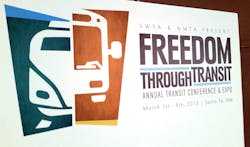The opening of the SWTA and NMTA conference and expo began with a look at how ADA legislation has transformed our lives and provided some personal insight in what that has done and the challenges still ahead.
Freedom Through Transit is the theme for the South West Transit Association and New Mexico Transit Association Annual Transit Conference & Expo, March 1-4, Santa Fe, New Mexico.
SWTA Board President Ken Savage, transit director, Fort Smith Public Transit in Fort Smith, Arkansas, said to attendees, “Freedom is the asset each of you help to bring to people every day.”
SWTA Executive Director Kristen Joyner said it has been a great partnership between SWTA and NMTA to bring this even together. Savage said it has provided for a professional development opportunity with education, partnerships and fun.
Jon Bulthuis, president, New Mexico Transit Association, and transportation department director, Santa Fe Trails Transit in Santa Fe, New Mexico said of the partnership, “It has provided a wonderful opportunity for us to be participating in a level of training we wouldn’t be able to bring to the state without that partnership.”
Tom Church, cabinet secretary, New Mexico Department of Transportation, gave a brief overview of the growing transit efforts in New Mexico. He said they’ve had 10 years’ worth of progress and have some legislative initiatives for funding, the most promising being a severance tax package which includes $3 million a year for five years for transit. At the local level, he said they’ve been working a real-time information, which is a big step for them and that they continue to move forward, “even though we’re in the holding pattern with federal funding like all of you.”
Freedom to Live Life
Freedom Through Transit will continue to be the theme for SWTA going forward, Joyner said, as it’s such an integral part of what it means for people. The opening session, sponsored by McDonald Transit, addressed the 25th anniversary of ADA legislation from the industry perspective and offered an emotional personal perspective.
Signing of ADA legislation took place on July 6, 1990, and Carol Wright, assistant VP, transportation and mobility, Easter Seals Project Action, said it has changed a lot and created a big change in America.
“Because it’s been 25 years, it’s important to put things in context,” she said. A few examples she gave included the story of two individuals that crawled out of their wheelchairs and dragged themselves on to a bus, paid the fare but were dragged off the bus by police for trespassing. At the time, Wright said bus riders were often angry and frustrated with the delays caused by disabled riders.
While the effect of ADA legislation would not be seen until years later, it has given us a lasting legacy. Wright said, “Gaps still exist but there have been giant steps forward … and continues to progress today.
“Work is far from finished. We shouldn’t be satisfied until all citizens receive equal treatment. By working together we can ensure that every individual in our nation has the opportunity to succeed.
“What you do, changes lives every day. Whether it’s freedom through transportation or is the ability for anyone anywhere to get where they need to go. You have the opportunity to make that difference each and every day.”
A Day in the Life
Trocye Crucchiola, storyteller and transit advocate, began his presentation talking about what most people did to get to the conference compared to what he did to get there. Most people rolled out of bed, showered, got to the airport, planes had to be taken, cars had to be driven.
“Let me tell you what it take for me,” he stated. As a patient on kidney dialysis, he had to go Thursday night at 7:30 p.m. for treatment until 3:30 a.m. It’s big needles, with big holes, he explained, so there’s anywhere from 10 to 20 minutes you have to hold pressure to stop the bleeding. Got home, ate and slept before he packed. On Saturday, dialysis again for 5 more hours. Went back home, rested and got up at 5 a.m. on Sunday to get to the conference.
For those not familiar with what dialysis really is like, which is most everyone, he gave an overview of what it entails, beginning with an explanation of what it feels like. He held up an anatomically correct model of one kidney and explained how the kidneys take care of all fluids that go in and out of our bodies – the master chemist of the body. “One of these, you can live your whole life with it, that’s how efficient they are,” he explained. People are not symptomatic to kidney disease until you lose 80 percent of its function. “And then you lose the kidneys.”
Dialysis is typically three days a week for four hours. At its best, for a person like himself, that provides for 15 percent replacement of one kidney. People on dialysis are symptomatic all the time: flu-like symptoms, puffy, week, tired, food doesn’t taste good. “Life is not the joy you want it to be,” Crucchiola said. “You feel crappy, you get stuck with huge needles and sit there for four hours to get done and feel wiped out. Most people in this regiment have to rest an equal amount of treatment.”
Crucchiola is employed by Ride Connection, working to improve transportation for people on dialysis. “I have never seen a coordinated transportation plan for kidney dialysis patients that really works.” He said there are pockets that work, but overall it falls short.
People will try to convince their doctors for shorter treatment times, they will skip a treatment if they don’t have the $5 for the ride, or he has also seen people still bleeding as they leave to try and catch their ride. As he explained how the four hours only brings the kidney function back to 15 percent, he said, “Minutes off of treatment means days off of their lives.”
“We’re people who want to work … a person wanting to live their lives,” Crucchiola said.
The pilot project of Ride Connection, in Portland, Oregon, has a grant that is 30 days into a pilot project with 27 patients. It has allowed them to do patient surveys, patient satisfaction groups and has organized volunteer drivers. The goal is to guarantee patients time – picked up on time, get them home on time.
“I want to share this program and I want to replicate it,” he said. “What you do is so important. You effect this community in such an important way.”
During the Q&A, he said it’s a billion dollar industry so the question was posed about partnerships between transit agencies and these companies providing dialysis. “Most people are clueless about what we go through,” said Crucchiola. “It’s easy for huge companies to maintain privacy in what they do.
“The transportation industry is an incredible venue. It’s an established industry. You shouldn’t be able to make a billion dollars a year and not kick down to help get people to their treatment.”
There is money to be made with the inefficiencies in the current hit-or-miss system. Looking to streamline the system, a dialogue with the companies to work with them. You’re already transporting their patients, working with those companies to get them there and get them home more efficiently, and more consistently.
Crucchiola said, “These companies make tons of money to keep us alive.
“We all make a clear choice in what we do … if we do that in the right spirit, we have a successful life.”




